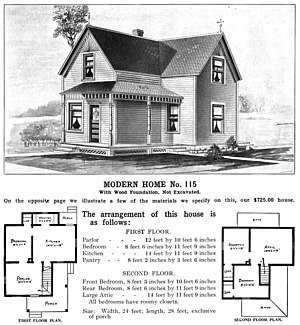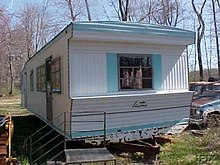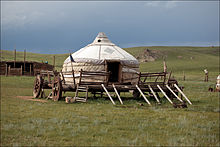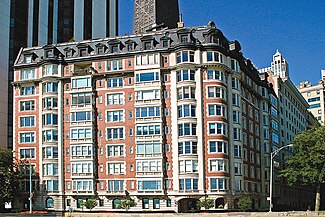Home
The examples and perspective in this article may not represent a worldwide view of the subject. (December 2021) |
| Part of a series on |
| Living spaces |
|---|
 |
A home, or domicile, is a space used as a permanent or semi-permanent residence for one or many humans. It is a fully or semi sheltered space and can have both interior and exterior aspects to it. Homes provide sheltered spaces for instance rooms, where domestic activity can be performed such as sleeping, preparing food, eating and hygiene as well as providing spaces for work and leisure such as remote working, studying and playing.
Physical forms of homes can be static such as a house or an apartment, mobile such as a houseboat, trailer or yurt or digital such as virtual space.[1] The aspect of ‘home’ can be considered across scales, from the micro scale showcasing the most intimate spaces of the individual dwelling and direct surrounding area to the macro scale of the geographic area such as town, village, city, country or planet.
The concept of ‘home’ has been researched and theorized across disciplines - topics ranging from the idea of home, the interior, the psyche, liminal space, contested space to gender and politics.[2] The home as a concept expands beyond residence as contemporary lifestyles and technological advances redefine the way the global population lives and works.
History
Prehistoric era
The earliest homes that humans inhabited were likely naturally occurring features such as caves. The earliest human fossils found in caves come from a series of caves near Krugersdorp and Mokopane in South Africa. The cave sites of Sterkfontein, Swartkrans, Kromdraai B, Drimolen, Malapa, Cooper's D, Gladysvale, Gondolin and Makapansgat have yielded a range of early human species dating back to between three and one million years ago, including Australopithecus africanus, Australopithecus sediba and Paranthropus robustus. However, it is not generally thought that these early humans were living in the caves, but that they were brought into the caves by carnivores that had killed them.[citation needed]
The first early hominid ever found in Africa, the Taung Child in 1924, was also thought for many years to come from a cave, where it had been deposited after being preyed upon by an eagle. However, this is now debated.[3] Caves do form in the dolomite of the Ghaap Plateau, including the Early, Middle and Later Stone Age site of Wonderwerk Cave; however, the caves that form along the escarpment's edge, like that hypothesized for the Taung Child, are formed within a secondary limestone deposit called tufa. There is numerous evidence for other early human species inhabiting caves from at least one million years ago in different parts of the world, including Homo erectus in China at Zhoukoudian, Homo rhodesiensis in South Africa at the Cave of Hearths (Makapansgat), Homo neanderthalensis and Homo heidelbergensis in Europe at Archaeological Site of Atapuerca, Homo floresiensis in Indonesia, and the Denisovans in southern Siberia.
In southern Africa, early modern humans regularly used sea caves as shelter starting about 180,000 years ago when they learned to exploit the sea for the first time.[4] The oldest known site is PP13B at Pinnacle Point. This may have allowed rapid expansion of humans out of Africa and colonization of areas of the world such as Australia by 60–50,000 years ago. Throughout southern Africa, Australia, and Europe, early modern humans used caves and rock shelters as sites for rock art, such as those at Giants Castle. Caves such as the yaodong in China were used for shelter; other caves were used for burials (such as rock-cut tombs), or as religious sites (such as Buddhist caves). Among the known sacred caves are China's Cave of a Thousand Buddhas[5] and the sacred caves of Crete. As technology progressed, humans and other hominids began constructing their own dwellings. Buildings such as huts and longhouses have been used for living since the late Neolithic.[6]
Ancient era
This section is empty. You can help by adding to it. (December 2021) |
Post-classical era
This section is empty. You can help by adding to it. (December 2021) |
Modern era
Common types
Static structures
A house is a single-unit residential building. It may range in complexity from a rudimentary hut to a complex structure of wood, masonry, concrete or other material, outfitted with plumbing, electrical, and heating, ventilation, and air conditioning systems.[8][9] Houses use a range of different roofing systems to keep precipitation such as rain from getting into the dwelling space. Houses may have doors or locks to secure the dwelling space and protect its inhabitants and contents from burglars or other trespassers. Most conventional modern houses in Western cultures will contain one or more bedrooms and bathrooms, a kitchen or cooking area, and a living room. A house may have a separate dining room, or the eating area may be integrated into another room. Some large houses in North America have a recreation room. In traditional agriculture-oriented societies, domestic animals such as chickens or larger livestock (like cattle) may share part of the house with humans.
The social unit that lives in a house is known as a household. Most commonly, a household is a family unit of some kind, although households may also be other social groups, such as roommates or, in a rooming house, unconnected individuals. Some houses only have a dwelling space for one family or similar-sized group; larger houses called townhouses or row houses may contain numerous family dwellings in the same structure. A house may be accompanied by outbuildings, such as a garage for vehicles or a shed for gardening equipment and tools. A house may have a backyard or a front yard or both, which serve as additional areas where inhabitants can relax or eat.
A homestead is an isolated dwelling, especially a farmhouse, and adjacent outbuildings,[10] typically on a large agricultural holding such as a ranch or station.[11]
In North America the word "homestead" historically referred to land claimed by a settler or squatter under the Homestead Acts (USA) or Dominion Lands Act (Canada). In Old English the term was used to mean a human settlement, and in Southern Africa the term is used for a cluster of several houses normally occupied by a single extended family.
In Australia it refers to the owner's house and the associated outbuildings of a pastoral property, known as a station.[12][13]Moveable structures
Miscellaneous

Management
Housing cooperative
A housing cooperative, or housing co-op, is a legal entity, usually a cooperative or a corporation, which owns real estate, consisting of one or more residential buildings; it is one type of housing tenure. Housing cooperatives are a distinctive form of home ownership that have many characteristics that differ from other residential arrangements such as single family home ownership, condominiums and renting.[18]
The corporation is membership based, with membership granted by way of a share purchase in the cooperative. Each shareholder in the legal entity is granted the right to occupy one housing unit. A primary advantage of the housing cooperative is the pooling of the members' resources so that their buying power is leveraged; thus lowering the cost per member in all the services and products associated with home ownership.Repair
Home repair involves the diagnosis and resolution of problems in a home, and is related to home maintenance to avoid such problems. Many types of repairs are "do it yourself" (DIY) projects, while others may be so complicated, time-consuming or risky as to suggest the assistance of a qualified handyperson, property manager, contractor/builder, or other professionals.
Repair is not the same as home improvement, although many improvements can result from repairs or maintenance. Often the costs of larger repairs will justify the alternative of investment in full-scale improvements. It may make just as much sense to upgrade a home system (with an improved one) as to repair it or incur ever-more-frequent and expensive maintenance for an inefficient, obsolete or dying system.Housekeeping
Housekeeping refers to the management of duties and chores involved in the running of a household, such as cleaning, cooking, home maintenance, shopping, and bill payment. These tasks may be performed by members of the household, or by other persons hired for the purpose. This is a more broad role than a cleaner, who is focussed only on the cleaning aspect.[19] The term is also used to refer to the money allocated for such use.[20] By extension, it may also refer to an office or organization, as well as the maintenance of computer storage systems.[21]
A housekeeper is a person employed to manage a household[22] and the domestic staff. According to the 1861 Victorian era Mrs. Beeton's Book of Household Management, the housekeeper is second in command in the house and "except in large establishments, where there is a house steward, the housekeeper must consider his/herself as the immediate representative of her mistress".[23]Tenure
Housing tenure refers to the financial arrangements under which someone has the right to live in a house or apartment. The most frequent forms are tenancy, in which rent is paid by the occupant to a landlord, and owner-occupancy, where the occupant owns their own home. Mixed forms of tenure are also possible.
The basic forms of tenure can be subdivided, for example an owner-occupier may own a house outright, or it may be mortgaged. In the case of tenancy, the landlord may be a private individual, a non-profit organization such as a housing association, or a government body, as in public housing.
Surveys used in social science research frequently include questions about housing tenure, because it is a useful proxy for income or wealth, and people are less reluctant to give information about it.Owner-occupancy
Rental accommodation
_png/220px-MEZ_1911_10_01_20_object_594901_(2).png)
Squatting
Squatting is the action of occupying an abandoned or unoccupied area of land or a building, usually residential, that the squatter does not own, rent or otherwise have lawful permission to use. The United Nations estimated in 2003 that there were one billion slum residents and squatters globally. Squatting occurs worldwide and tends to occur when people who are poor and homeless find empty buildings or land to occupy for housing. It has a long history, broken down by country below.
In developing countries and least developed countries, shanty towns often begin as squatted settlements. In African cities such as Lagos much of the population lives in slums. There are pavement dwellers in India and in Hong Kong as well as rooftop slums. Informal settlements in Latin America are known by names such as villa miseria (Argentina), pueblos jóvenes (Peru) and asentamientos irregulares (Guatemala, Uruguay). In Brazil, there are favelas in the major cities and land-based movements.
In industrialized countries, there are often residential squats and also political squatting movements, which can be anarchist, autonomist or socialist in nature, for example in the self-managed social centres of Italy or squats in the United States. Oppositional movements from the 1960s and 1970s created freespaces in Denmark or squatting village in the Netherlands, and in England and Wales, there were estimated to be 50,000 squatters in the late 1970s. Each local situation determines the context: in Athens, Greece, there are refugee squats; Germany has social centres; in Spain there are many squats.Homelessness
Homes may be lost in ways ranging from the upheavals of natural disasters,[24] fraud, theft, arson, or war-related destruction, to the more common voluntary sale, loss for one or more occupants on relationship breakdown, expropriation by government or legislated cause, repossession or foreclosure to pay secured debts, eviction by landlords, disposal by time-limited means – lease, or absolute gift. Jurisdiction-dependent means of home loss include adverse possession, unpaid property taxation and corruption such as in circumstances of a failed state.
Personal insolvency, development or sustaining of mental illness or severe physical incapacity without affordable domestic care commonly lead to a change of home. The underlying character of a home may be debased by structural defects, natural subsidence, neglect or soil contamination. Refugees are people who have fled their homes due to violence or persecution. They may seek temporary housing in a shelter or they may claim asylum in another country in an attempt to relocate permanently.
Anthropogenic significance
A home is generally a place that is close to the heart of the owner, and can become a prized possession. It has been argued that psychologically "The strongest sense of home commonly coincides geographically with a dwelling. Usually, the sense of home attenuates as one moves away from that point, but it does not do so in a fixed or regular way."[25] Since it can be said that humans are generally creatures of habit, the state of a person's home has been known to physiologically influence their behavior, emotions, and overall mental health.[26] People may become homesick when they leave their home over an extended period of time. Places like homes can trigger self-reflection, thoughts about who someone is or used to be or who they might become.[27] These types of reflections also occur in places where there is a collective historical identity, such as Gettysburg or Ground Zero.[28]
United Nation response
Article 25 of the Universal Declaration of Human Rights, adopted in 1948 by the United Nations General Assembly, contains the following text regarding housing and quality of living: "Everyone has the right to a standard of living adequate for the health and well-being of himself and of his family, including food, clothing, housing and medical care and necessary social services..."[29]
In 2004, the United Nations, Department of Economic and Social Affairs, defined a homeless household as "those households without a shelter that would fall within the scope of living quarters. They carry their few possessions with them, sleeping in the streets, in doorways or on piers, or in another space, on a more or less random basis."[30]
In 2009, at the United Nations Economic Commission for Europe Conference of European Statisticians recommended that homeless people are classified in two broad groups (noting that this would not provide a complete definition):[31]
- (a) Primary homelessness (or rooflessness). This category includes persons living in the streets without a shelter that would fall within the scope of living quarters.
- (b) Secondary homelessness. This category may include persons with no place of usual residence who move frequently between various types of accommodations (including dwellings, shelters, and institutions for the homeless or other living quarters). This category includes persons living in private dwellings but reporting ‘no usual address’ on their census form.
See also
Notes
References
- ^ "Definition: Home". Dictionary. Archived from the original on 28 October 2020. Retrieved 29 October 2020.
- ^ Briganti and Mezei, Chiara and Kathy (2012). The Domestic Space Reader. Canada: University of Toronto Press. ISBN 9780802099686.
- ^ Hopley, P.J.; Herries, A.I.; Baker, S.E.; Kuhn, B.F.; Menter, C.G. (2013). "Brief communication: Beyond the South African cave paradigm – Australopithecus africanus from Plio-Pleistocene paleosol deposits at Taung" (PDF). American Journal of Physical Anthropology. 151 (2): 316–324. doi:10.1002/ajpa.22272. PMID 23633001. S2CID 29825617. Archived from the original (PDF) on 22 September 2018. Retrieved 22 September 2018.
- ^ Marean, C.W.; Bar-Matthews, M.; Bernatchez, J.; Fisher, E.; Goldberg, P.; Herries, A.I.; Jacobs, Z.; Jerardino, A.; Karkanas, P.; Minichillo, T.; Nilssen, P.J.; Thompson, E.; Watts, I.; Williams, H.M. (2007). "Early human use of marine resources and pigment in South Africa during the Middle Pleistocene". Nature. 449 (7164): 905–908. Bibcode:2007Natur.449..905M. doi:10.1038/nature06204. PMID 17943129. S2CID 4387442. Archived from the original on 22 September 2018. Retrieved 22 September 2018.
- ^ Olsen, Brad (2004). Sacred Places Around the World: 108 Destinations. CCC Publishing. p. 16. ISBN 978-1-888729-16-0. Archived from the original on 21 May 2021. Retrieved 2 December 2020.
- ^ "Skara Brae". Orkneyjar. Archived from the original on 9 December 2012. Retrieved 8 December 2012.
- ^ Hill, Jim (12 September 2015). "The smart home: a glossary guide for the perplexed". T3. Retrieved 27 March 2017.
- ^ Schoenauer, Norbert (2000). 6,000 Years of Housing (rev. ed.) (New York: W.W. Norton & Company).
- ^ "housing papers" (PDF). clerk.house.gov. Archived from the original (PDF) on 17 January 2013. Retrieved 18 December 2012.
- ^ "homestead". Oxford English Dictionary (Online ed.). Oxford University Press. (Subscription or participating institution membership required.)
- ^ Taylor, John (1995). Methodology for identification and assessment of rural homesteads and farm houses in the Great Southern area of Western Australia. Royal Institute of Architects (W.A.) and the Heritage Council of W.A.
- ^ Taylor, Peter (1988), Station life in Australia : pioneers and pastoralists, Allen & Unwin, ISBN 978-0-04-332135-5
- ^ "Chisholm, Alec H.". The Australian Encyclopaedia. Vol. 8. Sydney: Halstead Press. 1963. p. 275.
- ^ Parry, M. H. (2000). Aak to Zumbra: a dictionary of the world's watercraft. Newport News, VA: Mariners' Museum. pp. 215–216. ISBN 0917376463.
- ^ Gabor, M. (1979). Houseboats from Floating Places to Humble Dwellings - a glowing tribute to a growing lifetsyle. Toronto: Ballantine Books.
- ^ "Model Homes Locator | Easily Find Model Homes near you". Model Homes Locator. Retrieved 21 January 2020.
- ^ Oxford English Dictionary. Oxford University Press. 2013.
'a house on a newly built estate which is furnished and decorated to be shown to prospective buyers'.
- ^ "The Characteristics of Housing Cooperatives". Retrieved 2 May 2015.
- ^ "What's the Difference Between Housekeeping and Cleaning". ThinkACW.
- ^ "housekeeping" Oxford Dictionaries Online. Retrieved 2 June 2013.
- ^ "housekeeping" The Collins English Dictionary. Retrieved 2 June 2013.
- ^ "housekeeper" Oxford Dictionaries Online. Retrieved 2 June 2013.
- ^ Mrs. Beeton's Book of Household Management Web version of the book at the University of Adelaide Library. Retrieved 2 June 2013.
- ^ Teves, Hranjski, Oliver, Hrvoje (7 December 2012). "Death toll from Philippine typhoon climbs past 500". USA Today. Archived from the original on 8 December 2012. Retrieved 8 December 2012.
- ^ Terkenli, T.S. (1995). "Home as a Region". Geographical Review. 85 (3): 324–334. doi:10.2307/215276. JSTOR 215276.
- ^ Boutruche, Samuel; Bourgeois, Stéphanie; Lyamouri-Bajja, Nadine (2008). Raising Young Refugees' Voices in Europe and Beyond. Council of Europe. p. 35. ISBN 978-92-871-6308-0. Archived from the original on 10 June 2016. Retrieved 19 November 2015.
- ^ Haywood, Trudy (27 July 2017). "Homesickness – Settling in to University". Warwick. Archived from the original on 4 January 2018.
- ^ Burton-Christie, Douglas (2009). "Place-Making as Contemplative Practice". Anglican Theological Review. 91 (3): 347–371. Archived from the original on 2 May 2014. Retrieved 30 April 2014.
- ^ "Article 25 of the Universal Declaration of Human Rights". Price Council. Price Council. 10 December 1948. Archived from the original on 30 July 2022. Retrieved 2 May 2022.
- ^ "United Nations Demographic Yearbook review: National reporting of household characteristics, living arrangements, and homeless households : Implications for international recommendations" (PDF). United Nations, Department of Economic and Social Affairs, Statistics Division, Demographic and Social Statistics Branch. 14 April 2004. Archived (PDF) from the original on 16 May 2013. Retrieved 20 November 2013.
- ^ "Enumeration of Homeless People" (PDF). Price Council. Price Council. 18 August 2009. Archived (PDF) from the original on 2 May 2022. Retrieved 2 May 2022.


_jpg/220px-8A-_Bulevardul_Aviatorilor_-_Bucharest_(Romania).jpg)






